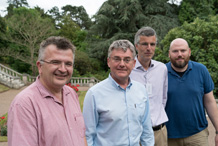Articles

From left-to-right: Aleksandar Pavic (University of Exeter), Andrew Gill (IfM), James Talbot (University of Cambridge) and Michael Wesolowsky (Swallow Acoustics, Canada).
World experts converge in Exeter to tackle structural vibration as ‘global challenge’
Experts in vibration serviceability of civil engineering structures from across the globe met at the University of Exeter over two days to discuss the growing challenge of vibrating structures. The best known example of this problem was the ‘wobbly’ Millennium Bridge in London, a case that brought the field of vibration serviceability from obscurity into the limelight 16 years ago.
The aim of the meeting was to form a new alliance for international collaboration, to tackle the growing problem of vibrating structures, such as tall and super-tall buildings, building floors, stadiums, shopping centres, bridges and concert venues. As structural materials become stronger and structures lighter, they also become more lively under wind, over- and under-ground traffic and human-induced loading, such as walking, running or jumping. Over 20 key international stakeholders from industry and academia across eight countries and four continents participated in the two-day ‘research roadmapping’ workshop.
The UK has always been at the forefront of civil structural vibration serviceability research. So, driven by the University of Exeter team led by Professor Aleksandar Pavic, the overseas experts joined with UK representatives from the Universities of Exeter, Cambridge, Leicester, Bath and Warwick. The aim of the meeting was to develop international strategy to manage worldwide research effort and to convince national and international funding bodies, government, industry and other organisations that structural vibrations are one of the unsolved socio-technological ‘grand challenges’ facing humanity. The solution to this problem requires the collaborative effort of many disciplines, including psychologists, architects and data scientists. The group’s ambitions are also to establish an International Vibration Serviceability Institute, and to launch a new peer-reviewed international journal for the specialty.
The workshop was organised by the Vibration Engineering Section (VES) research team at the University of Exeter, and delivered by the Institute for Manufacturing at the University of Cambridge (IfM).
The University of Exeter, which hosted the conference at its Streatham campus, has a world-renowned centre of excellence in vibration serviceability, as a result of a multi-£m investment made in VES since 2013. This includes the development of a unique £1-million laboratory, featuring state-of-the-art vibration serviceability technology, including a world first, commercially developed active mass damper for suppressing crowd-induced vibrations, and five 15-tonne full-scale structures, reconfigurable into two 15m long laboratory footbridges, or three floors, one at a time.
At the workshop, which was the brainchild of Professor Pavic, the 29 collaborators from the UK, USA, Canada, Brazil, Australia, Belgium, Switzerland and Germany discussed how to stop real-life structures from vibrating too much. Structural vibration is increasingly recognised as a hazard for human well being, and is causing annoyance as well as disruption for sensitive healthcare and industrial processes, such as medical operations and the manufacturing of micro-electronics. A strategy for addressing the challenge over the next 25 years has been formulated through a formal ideas solicitation process facilitated by IfM.
Professor Pavic, from the College of Engineering, Mathematics and Physical Sciences, said: "It's been a fantastic couple of days and really interesting to hear the different perspectives of top experts across industry and academia.
"Vibration serviceability is becoming a key design criterion, rapidly replacing structural strength considerations when determining the size and shape of buildings. The construction sector as a whole needs to up its game considerably when dealing with the multi-£bn problem of preventing structures from vibrating too much. As London has decided to go ‘up’ instead of going ‘out’, there are now plans to construct more than 200 tall buildings, with at least 20 floors, in London alone, between now and 2030. Needless to say, their design is very much driven by the need to avoid this problem, and this consumes an enormous amount of human and material resources, which need continuous evaluation and optimising through research.
“I am delighted that participants from all over the world were so keen to be involved with this and with us in Exeter, which highlights the importance of addressing the issue. We are really looking forward to continuing to work together, to ensure these issues are addressed across the world over the next 25 years."
Michael Wesolowsky, Vice President of Swallow Acoustics, Noise and Vibration Control, who travelled from Canada to attend the workshop, said: “I am encouraged to see, for the first time in my experience, an almost equal representation of industrialists and academics. I hope this will be a basis for bridging the gap that has existed for quite some time between theory and reality, between laboratory experiments and practical application in the real world.”
The workshop was facilitated by Andrew Gill, a Senior Industrial Fellow from the IfM. He said: "It was a highly successful exercise and it's great that the University of Cambridge's Institute for Manufacturing was able to collaborate with the University of Exeter on this important project. Roadmapping is a really powerful way of bringing together different stakeholders to develop strategy. We were able to bring together and draw on the knowledge of civil and structural engineers as well as other researchers with different areas of expertise from all over the world."
Date: 25 July 2016
